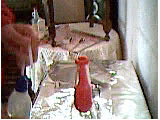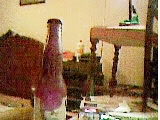


|
Sucked Balloon
Science at Home |
||
|
Materials
|
Compounds
|
Videos: download.avi (650 KB)
Pictures: 

|
|
Procedure
1. Pour a spoon of water in an empty bottle. 2. Heat the water in the bottle, with the alcohol lamp flame. (the heating of the water can be made in a microwaves or in a stove with low heating intensity. Do not subject the glass to very high temperatures because it can break) 3. Leave the water boiling for two minutes. (the bottle will be very hot and full of vapor inside, thus be very CAREFUL!) 4. With two forks remove the bottle of heating. (CARE with your hands, the glass is very hot!) 5. Carefully, place a balloon in the bottle mouth. (the balloon should be placed perfectly in the vertical) 6. Next, leave the bottle to cool until room temperature is reached. (if you want to accelerate the process, you can add cold water to the glass bottle walls. Add water little by little, because the bottle can break due to the temperature abrupt variation) 7. In the end, you can notice that the balloon is full sucked into the bottle. (if the balloon isn't well placed, it can burst prematurely) |
||
|
Why?
A balloon that enters alone into a bottle? This result reminds us the experiment "Imploding can". In that experiment, however, the water change from vapor to liquid is very abrupt. In contrast, in this experiment the evolution of the vapor condensation can be slowly seen, thanks to the low rate temperature change. When the water inside the bottle is warmed its temperature increases slowly until ebullition temperature. Leaving the water in ebullition, during some time, the generated vapor will occupy, almost, all the inside bottle volume. After that, the balloon is placed in the bottle mouth to accompanying the vapor condensation evolution. Then, the temperature inside the bottle will decrease, making the vapor to condense. As the vapor is condensing, the balloon will occupy the volume that the vapor occupied in the beginning to compensate the pressure variation (low pressure inside). The balloon continues to be sucked until it stops when it's reached an pressure equilibrium between vapor and liquid inside the bottle. This experiment is an evident proof that a gas occupies more volume than a liquid. Try it at home, but be carefull with the hot glass!
|
||
No part of this website can be reproduced without previous authorization. Please inform me if there is any problem with the website. |